
Moorcroft 'Cairns Butterfly' Ginger Jar - Limited Edition Trial
A Moorcroft Trial 'Cairns Butterfly' ginger jar and cover, designed by Vicky Lovatt, 2017 the 769/6 shape trial ginger jar for a limited edition of 40 in the 'Icons of Australia' series, decorated with two 'Cairns birdwing' (Ornithoptera euphorion)…

Moorcroft 'Nasturtium' Ginger Jar and Cover by Sally Tuffin
A Moorcroft 'Nasturtium' ginger jar and cover, designed by Sally Tuffin, 1992 the 769/6 shape ginger jar, in numbered edition for the Moorcroft Collectors club, decorated with vibrant nasturtiums in shades of orange and yellow against a pale green ground…

Moorcroft 'Hibiscus' Plate, 'Wisteria' Vase, 'Anemone' Dish, Ginger Jar
Moorcroft 'Hibiscus' plate on green ground, miniature 'Wisteria' vase, 'Anemone' dish and ginger jar, (4 items), factory marks to the bases, the plate 21.5 cm diameter

Moorcroft 'Anemone' Ginger Jar on Blue Ground, 20 cm
Moorcroft 'Anemone' pattern ginger jar on blue ground, impressed signature mark 'Moorcroft potter to H.M. The Queen, made in England', with original matching circular paper label, 20 cm high

Limited Edition Moorcroft 'King Lear' Ginger Jar by Rachel Bishop
A Moorcroft limited edition 'King Lear' ginger jar, designed by Rachel Bishop for the Shakespeare series, late 1990s, the 769/6 ginger jar and cover, from the Shakespeare series made for black and white Thornton of Stratford-upon-Avon, tube-line decorated…

Moorcroft 'Carousel' Ginger Jar by Rachel Bishop, 1997, Boxed
A Moorcroft 'Carousel' pattern ginger jar, designed by Rachel Bishop, 1997, the 769/6 ginger jar and cover, tube-line decorated with rose hips, primroses and foliage against a rich jade washed ground, with impressed Moorcroft stamp, numbered 1193, painted…
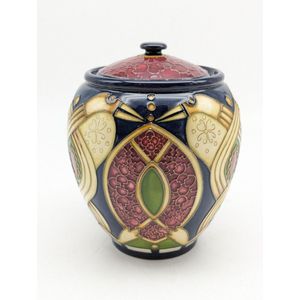
Moorcroft Pottery 'Staffordshire Gold' Ginger Jar, Signed 2010, Boxed
Moorcroft Pottery, lidded ginger jar 'Staffordshire Gold' signed and dated 2010 to base, with original box., height 15 cm

Moorcroft Flambe Claremont Ginger Jar, Signed, 20.5 cm
Moorcroft: a ginger jar in the flambe Claremont design, painted signature and impressed marks to base. Height 20.5 cm. Provenance: The Estate of the Hon. Dr John Kennedy McLaughlin Am, Sydney

Moorcroft 'Fairy Rings' Ginger Jar by Philip Richardson, c1987
A Moorcroft 'Fairy Rings' ginger jar, Des. Philip Richardson, c1987, the shape 769/6 ginger jar, with a whimsical design of 'Fairy ring' mushrooms (Marasmius oreades) encircling the body and adorning the cover, in a unique palette of brown and cream…
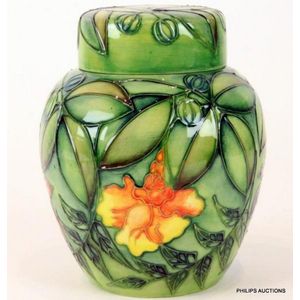
Moorcroft Rainforest Ginger Jar with Original Box
A Moorcroft 'Rainforest' ginger jar, designed by Sally Tuffin circa 1992, the 'Rainforest' pattern ginger jar, painted by Wendy Mason, marked 'Philip happy 40th love, Jayne' with impressed Moorcroft stamp and other ciphers, in its original box. Height 15…

Moorcroft 'Trout' Ginger Jar by Philip Gibson
A Moorcroft 'Trout' ginger jar, designed by Philip Gibson circa 1988, the 'Trout' pattern ginger jar, painted by Wendy Mason, with impressed Moorcroft stamp and other ciphers, in its original box. Height 15.5 cm

Limited Edition Lion Ginger Jar by Moorcroft
A limited edition Moorcroft 'Pride of Lions' pattern ginger jar and cover, designed and signed by Sian Leeper and dated 1999, painted by Anji Davenport (signed and dated 12.9.01), the ginger jar tube-line decorated in 'Pride of lions' with the Serengeti…

Moorcroft Golden Jubilee Ginger Jar with Emma Bossons Design
A Moorcroft lidded ginger jar, ERII Golden Jubilee pattern, designed by Emma Bossons for the 2002 jubilee with Jubilee backstamp

Moorcroft Flame of the Forest Ginger Jar
A Moorcroft ginger jar, Flame of the Forest pattern, designed by Philip Gibson, c.1997

Limited Edition Moorcroft Ginger Jar 'The Winter's Tale'
A limited edition Moorcroft 'The Winter's Tale' ginger jar and cover, commissioned by B & W Thornton, the Shakespeare collection, c1993, the ginger jar decorated with tube-lined flowers in landscape against a tonal pink wash ground, with impressed…

Moorcroft Nasturtium Ginger Jar with Cover
A Moorcroft 'Nasturtium' ginger jar and cover, designer Sally Tuffin, (1992) for the Moorcroft Collectors Club, numbered 288. Shape 79/6, height 16 cm.

Moorcroft Balloon Ginger Jar by Philip Gibson
A Moorcroft ginger jar 'Balloon', designer Philip Gibson (1998), Shape 169/4, height 11 cm. Historic retail $NZ900.

Signed Moorcroft Honeysuckle Ginger Jar by Sarah Brummell-Bailey
A Moorcroft ginger jar, Honeysuckle pattern, designed by Sarah Brummell-Bailey (2000) 4 star collectors club, signed, height 15.5 cm

Moorcroft Wisteria Flutter Ginger Jar, 2010 Ovoid Shape
A Moorcroft small ginger jar, Wisteria Flutter pattern, 2010 ovoid shape 769/4, height 11 cm

Moorcroft Melody Ginger Jar by Sian Leeper
A Moorcroft small ginger jar, Melody pattern, designer Sian Leeper, shape 576/4, height 11 cm.

Limited Edition Moorcroft Ginger Jar in Cream Magnolia Pattern
A large Moorcroft ginger jar, Cream Magnolia pattern, designer Emma Bossons, limited edition 46/100 shape 769/8, height 32 cm, signed by Vicki Lovatt and Emma Bossons. Historic retail $NZ1930.

Moorcroft Fish Ginger Jar 2005
A contemporary Moorcroft ginger jar, marked 38/50 and dated 2005. Features a raised, graphic fish pattern with a dark blue interior. transferred Moorcroft stamp to base, height 16.5 cm, width 15 cm

Moorcroft Anemone Ginger Jar, 1949-1986
A Moorcroft 'Anemone' ginger jar, 1949-1986 period, the covered jar having a broad tubelined frieze of anemone in mottled deep blue purple and plum colours with citrus tone foliage on a dark cobalt ground, painted Walter Moorcroft signature and impressed…

1990 Anemone Pattern Ginger Jar by John Moorcroft
John Moorcroft ovoid ginger jar and cover anemone pattern circa 1990 20 cm height
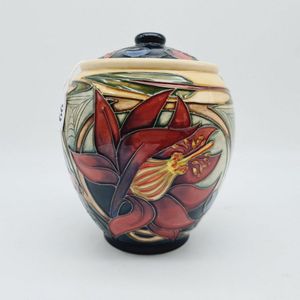
Emma Bossons Moorcroft Lidded Ginger Jar (2002)
Moorcroft Hartgring, lidded ginger jar by Emma Bossons 2002, height 15 cm

Signed Moorcroft Ginger Jar with Flower Design
Flowers ginger jar Moorcroft flowers, lidded ginger jar, signed Kerri 2000 to base, height 16 cm

Rare Moorcroft Honeycomb Ginger Jar by Philip Richardson
Rare Moorcroft 'Honeycomb' pattern ginger jar designed by Philip Richardson (this pattern was only retailed for just over a year and later discontinued), height 15 cm

Small Moorcroft Ginger Jar with Lid (Factory Seconds)
An attractive Moorcroft lidded ginger jar of small proportions (factory seconds with red dot to base)

Limited Edition Robin Ginger Jar by Moorcroft Pottery
Moorcroft Pottery ginger jar, Robin, designed by Phillip Gibson 2005, limited edition 66/75, 15 cm high

Moorcroft Nasturtium Ginger Jar by Sally Tuffin (1992)
Moorcroft Pottery lidded ginger jar, Nasturtium, designed by Sally Tuffin for the Collectors club in 1992, 15 cm high

Signed Moorcroft 'Anemone' Lidded Ginger Jar - 15cm Height
Walter Moorcroft 'Anemone' lidded ginger jar, signed and factory stamp to base, height 15 cm

Walter Moorcroft Anemone Ginger Jar
Walter Moorcroft 'Anemone' lidded ginger jar, stamp to base, height 10.5 cm
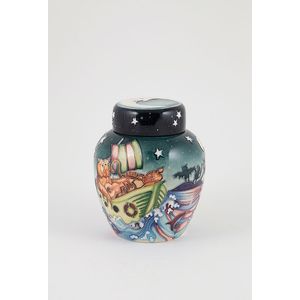
Limited Edition Moorcroft Ginger Jar with Owl and Pussycat Pattern
Moorcroft boxed circa 2004 ginger jar and cover owl and Pussycat pattern signed Nicola Slaney limited edition 37/250

Moorcroft Miss Alice Ginger Jar with Cover (2005)
Moorcroft boxed circa 2005 ginger jar and cover Miss Alice pattern 15.5 cm

Limited Edition Moorcroft Ginger Jar - Hickory Dickory Dock
Moorcroft boxed circa 2005 ginger jar and cover Hickory Dickory Dock pattern signed limited edition 43/250 15.5 cm

Moorcroft Anemone Ginger Jar with Cover
Moorcroft boxed circa 2002 ginger jar and cover anemone Tribute pattern 16 cm

Limited Edition Moorcroft Ginger Jar in Othello Pattern
Moorcroft boxed circa 2005 ginger jar and cover Othello pattern signed Rachel Bishop limited edition 4/ 250 16 cm

Limited Edition Moorcroft Griffins Ginger Jar
Moorcroft boxed circa 2011 ginger jar and cover dance of the griffins pattern signed Vicky Lovatt limited edition 47/100 25 cm

Modern Moorcroft Magnolia Ginger Jar & Cover (Boxed)
Modern Moorcroft ginger jar & cover Magnolia pattern, 20 cm height, boxed

Moorcroft Pottery: Anemone, Pansy, and Pin Dish
Moorcroft Pottery, 3pcs i.anemone lidded ginger jar, height 10.8 cm ii.Pansy vase, height 9.2 cm iii.anemone pin dish diameter 12 cm

Limited Edition Cheetah Pattern Ginger Jar by Moorcroft (Anji Davenport)
Moorcroft boxed c.2003 ginger jar and cover cheetah pattern signed Anji Davenport, limited edition 28/150, 20 cm

Moorcroft Loch Hope Ginger Jar - 15.5 cm (2004)
Moorcroft boxed c.2004 ginger jar Loch Hope pattern 15.5 cm

Moorcroft Carousel Centenary Ginger Jars (Pair)
A pair Moorcroft Pottery Carousel Centenary ginger jars designed 1997 by Rachael Bishop numbered edition 167 & 174 signed by John Moorcroft with various others marks height 15.5 cm

Moorcroft 'Hibiscus' Ginger Jar, 15.5 cm Height
Walter Moorcroft 'Hibiscus' ginger jar. Initialled 'Wm' and impressed mark 'Moorcroft made in England' to base. Height 15.5 cm

Moorcroft Clematis Ginger Jar with Labels, C.1950s
Walter Moorcroft, small Clematis ginger jar, C.1950s, with original labels on lid and base and 769. Minor imprefection to lid glaze., height 10.5 cm, diameter 8.5 cm, weight 266g

Moorcroft Pomegranate Ginger Jar and Cover, 19cm
William Moorcroft ginger jar and cover pomegranate pattern, 19 cm height

Moorcroft Anemone Ginger Jar
A Moorcroft ginger jar, decorated with an Anemone pattern on a dark blue ground. Impressed marks and original label. Height 16 cm

Moorcroft Ginger Jar by Sue Pointon
Sue Pointon for Moorcroft, Ginger Jar, c. 1997, 'Flames of the Forest' pattern, decorated with orange and yellow flowers against a green and ochre ground, signed in blue 'WM' and in green 'sp' for Sue Pointon, impressed 'Moorcroft, Made In England, height…
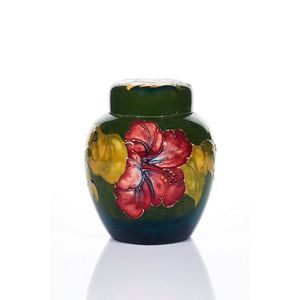
Moorcroft Hibiscus Ginger Jar
Walter Moorcroft, Ginger Jar, c. 1960, 'Hibiscus' pattern, decorated with mauve and yellow hibiscus against a green ground, signed in blue 'W. M.', impressed 'Moorcroft, Made in England, height 15 cm. Provenance: The Estate of Mary Smart

Moorcroft Ginger Jar, 'Dawn' Pattern, 1926
William Moorcroft, Ginger Jar, c. 1926, 'Dawn' pattern, decorated with a band of trees and hills in blue against a pale sky between borders of chevrons, in a matt glaze, signed in blue 'WM', impressed 'Moorcroft, Made in England, height 15 cm. Provenance:…

William Moorcroft Anemone Ginger Jar
A William Moorcroft small ginger jar, anemone pattern in tubeline relief, traditional tones of red, mauve and green on dark blue ground, the lid labelled, the base with impressed marks. Height 11 cm
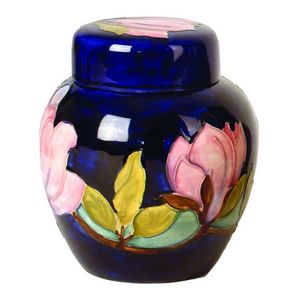
Moorcroft Magnolia Ginger Jar
A modern Moorcroft 'Magnolia' lidded ginger jar, dark blue ground with salmon pink flowers highlighted with green leaves and brown stems, impressed marks and painted initials in green. Height 15.2 cm

Moorcroft Magnolia Ginger Jar
William Moorcroft ginger jar & cover Magnolia pattern, painted initial mark, still with paper labels to base & cover, 17 cm height

Signed Moorcroft Magnolia Ginger Jar
Walter Moorcroft lidded ginger jar. Magnolias on blue ground. Signed to base. Height 21 cm

Moorcroft Albany Ginger Jar by Nicola Slaney
A Moorcroft Albany design ginger jar. Designed by Nicola Slaney. 17 cm high

Blue Finches Ginger Jar by Sally Tuffin - 21cm
A Moorcroft Finches Blue ginger jar designed by Sally Tuffin. 21 cm high

Moorcroft Flambe Ginger Jar with Leaf and Berry Pattern
William Moorcroft ginger jar Flambe 'Leaf and Berry' pattern signed to base 'Moorcroft', impressed to base 'Potter to H. M. The Queen' and 'Made in England'. Height 16 cm
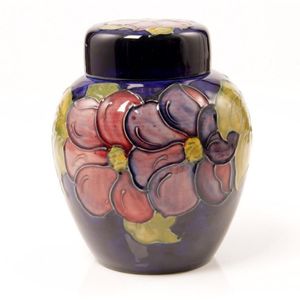
Signed Walter Moorcroft Clematis Ginger Jar
A Walter Moorcroft clematis ginger jar impressed and signed. Height 15.5 cm. Diameter 13.5 cm

Moorcroft Carousel Ginger Jar
A Moorcroft Pottery 'Carousel' ginger jar, 2012, by Emma Bossons, numbered edition #85. Emma Bossons has combined the floral designs of several Moorcroft designers, into one 'Carousel', design., signed with makers stamp to base. Height 20 cm

Nicola Slaney's Trillium Ginger Jar
A Moorcroft 'Trillium' ginger jar, c.2000, designed by Nicola Slaney. Height 15 cm

Hibiscus Moorcroft Lidded Ginger Jar
Moorcroft lidded ginger jar featuring hibiscus flower with brown background, with impressed 'Moorcroft' stamp and 'Made in England' stamp. Height 16 cm
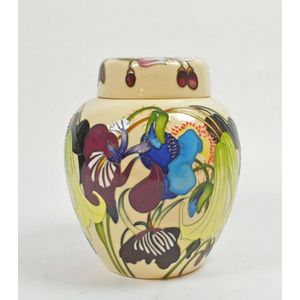


 Loading more...
Loading more...